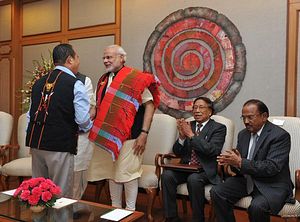On the 68th year of India’s independence, a new security success is emerging on the country’s eastern flank. The security relationship with India’s neighbors, excluding Pakistan, has begun to improve dramatically, thanks to a series of agreements, initiatives and interventions over the last year. These promise an era of stability in a region that has always been predisposed to peace.
The recent developments related to the Naga peace accord, the withdrawal of the Armed Forces (Special Powers) Act (AFSPA) from Tripura and the activation of India-Bangladesh Land Boundary Agreement (LBA) have resolved sore issues dating back to 1947. The intervention in Myanmar to flush out groups of northeastern insurgents will bring normalcy to the contiguous borders of both states, so important for cross-border trade. Signing the road connectivity agreement between Bangladesh, Bhutan, India and Nepal (BBIN), will enable free movement between most of South Asia, and therefore revive old linkages.
This trail of regional prosperity is long overdue, largely held back by the indifference of policymakers in New Delhi. When coupled with lack of governance, it made interference from China and Pakistan on India’s borders easy, enslaving the region to violent insurgencies and trans-border criminal activity.
Should the new security cooperation be institutionalized and prevail, it will clear the way for economic cooperation all the way into southeast Asia, realizing India’s “Act East” promise.
Agreements:
Nagaland: On 3 August, the Government of India signed a peace accord to end one of the most violent insurgencies afflicting the northeast–the Naga insurgency. The Nagas had been demanding independence from India since 1947, seeking a “Nagalim” or Greater Nagaland. Though India quelled successive rebellions, the Naga yearning for independence remained and consolidated when the National Socialist Council of Nagaland (NSCN) was formed in 1980. It blocked India off from southeast Asia and its tiger growth.
The details of the current accord are not yet finalized. But both sides appear to have reconciled their differences. In return for the NSCN – through its dominant Isak-Muivah faction – giving up its demand for independence, New Delhi will give greater autonomy to the Naga tribes. This has already been successfully experimented with the Bodos and their Territorial Council. Dismantling the NSCN’s parallel governance structures – including its taxation/extortion racket – will be a major challenge. Still, in a region full of violent insurgencies, the accord is a positive signal to other warring groups to consider the option of dialogue and become part of the Indian democratic mainstream.
Bangladesh: In a landmark development, India and Bangladesh ratified and activated the LBA on 6 June. As part of this, on 1 August, the two swapped more than 150 border enclaves, marooned in-between since the 1947 Partition. The undefined border had hampered India’s efforts to build boundary infrastructure and control militant infiltration, fake currency and cattle smuggling.
With this agreement, India has added more than 15,000 citizens from the former Bangladeshi enclaves in West Bengal, Assam, Tripura and Meghalaya. This deal will go a long way in complementing Bangladeshi Prime Minister Sheikh Hasina’s crackdown on religious extremist groups and anti-India militant outfits operating within Dhaka’s borders.
BBIN agreement: Simultaneous with these security developments, was the signing of the BBIN connectivity agreement, which will connect India’s northeeast with its surrounding neighbors. This sub-regional integration will be sure to reap economic rewards. Complementing this initiative will be an Indian push on the Bay of Bengal Initiative for Multi-Sectoral Technical Cooperation through economic cooperation and infrastructure buildup.
Initiative:
Tripura: On 27 May, Tripura withdrew the AFSPA– a controversial 1958 legislation which grants extraordinary powers to security forces. It was promulgated at a time when the Indian Army needed to intensify its counter-insurgency operations against the Naga rebels. But multiple insurgencies broke out in the region, and the Act’s coverage was expanded to cover most of the northeast. The subsequent local allegations of human rights violations by the security forces became a sore between civil society demanding revocation of the act, and the armed forces which cited the need for legal protection while discharging their duties in “disturbed areas.” Tripura’s decision on AFSPA is larger than a victory for civil society efforts; it will bring normalcy to the region and reinforce the goals of improved governance and economic development.
Intervention:
Myanmar: On 9 June, India carried out a cross-border raid in Myanmar to flush out Naga and Manipuri militants, who were responsible for several audacious attacks on the Indian Army. It demonstrated India’s military resolve and reiterated the successful model of security cooperation with a neighbor (as with Nepal and Bhutan).
Clearly, the road to Indian and regional prosperity lies eastwards. The western borders continue to be fraught with danger. Perhaps the experiments with peace-making on the east will serve as an exemplar to the generals in Rawalpindi and extend the promise of stability across the entire region.
Sameer Patil is Fellow, National Security, Ethnic Conflict and Terrorism, at Gateway House. This article was originally published at Gateway House: Indian Council on Global Relations, a foreign policy think tank in Mumbai, India, established to engage India’s leading corporations and individuals in debate and scholarship on India’s foreign policy and the nation’s role in global affairs.

































